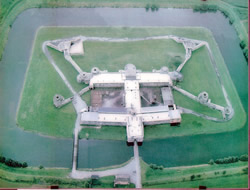Battles of Antwerp, the Yser (IJzer) & the Belgian Coast: Introduction
Violation of Belgian Neutrality
On 1 August 1914 the German goverment sent an ultimatum to the Belgian government requiring passage for its Armies through Belgium to carry out the advance into northern France. The Belgian King Albert I and the Belgian government refused, having stated a few days earlier, on 24 July, that Belgium would not allow passage to German forces intent on attacking France. Belgium was determined to maintain its neutral status. According to the Treaty of London of 1839 the Kingdom of Belgium was guaranteed its independence and neutrality by the co-signatories: Great Britain, Austria, France, the German Confederation (led by Prussia), Russia, and the Netherlands.
The Belgian Army was mobilised on 31 July 1914. On 3 August the British government guaranteed armed support to Belgium if Germany violated Belgian neutrality. On 4 August the German government declared war on Belgium and the three northernmost armies on the right wing of the German advance (1st, 2nd and 3rd Armies) crossed the Belgian border and attacked the city of Liège.
The violation of the treaty of 1839 by Germany was instrumental in bringing about the British declaration of war against Germany in defence of Belgian neutrality. Later that evening at 23.00 hours Britain declared war on Germany.
Following the invasion of hostile German forces King Albert I of Belgium decided to take personal charge as Supreme Commander of the Belgian Army. This was not entirely in accordance with the terms of the constitution. The Prime Minister Charles de Broqueville was unhappy that Albert refrained from allowing civilian ministers to be involved with the military decision-making. For the four following years of the war Albert maintained personal command of the army and also refused to allow the Belgian Army to be placed under Allied command. He took on a personal responsibility to maintain the role of the small Belgian Army to defend the nation and, only at such a time as it would be in a position to do so without incurring avoidable heavy losses, to take back its lost territory.
Belgian Government & Army Withdraw to Antwerp
Liège fell to the German Army on 7 August. The Germans continued their advance to the capital Brussels. From 17 August 1914 the Belgian government withdrew to the fortified city of Antwerp on the Schelde River. The city was protected by an outer and inner ring of forts built between 1859 and 1914. It was designated as a National Redoubt (Réduit national/de versterkte stelling Antwerpen) in the event that Belgium might be attacked. The perimeter of the fortifications around the city was about 60 miles (95km). A garrison of 80,000 second-line troops was there to defend it.
Capture of Brussels
The Belgian Army held out against the advancing German forces at the Battle of the Gette, but on 19 August also began to fall back to Antwerp. King Albert set up his headquarters in the fortress city. On 20 August the Germans occupied Brussels. It would remain under German occupation until 18 November 1918.
Meanwhile, the German advancing forces attacked, besieged and captured two more fortified towns in the southern Belgian border region: Mons (24 August) and Namur (25 August).
Germans Attack Antwerp Forts
On 4 September the German artillery fired on the forts due south of the city at Waelhem and Breendonk. For the next two weeks the events of Battle of the Marne were the focus of attention for the German Supreme Command. On 14 September after the battle General Helmuth von Moltke resigned his position as Supreme Commander. He was succeeded by General Erich von Falkenhayn. German attacks on the forts at Antwerp began again from 22 September. This time the German artillery bombarded the forts from Waelhem to Lier in the south-east sector.
Related Topic

Fortress of Breendonk National Memorial
One of the forts in the ring of forts around Antwerp is open to visitors.
Fortress of Breendonk National Memorial
Breendonk Fort photo licensed under Creative Commons. (1)
Acknowledgements & Sources
The dates have been taken from a 1987 reprint of the following book first published in 1922 by His Majesty's Stationery Office: History of the Great War - Principal Events 1914-1918. ISBN - 0 948 13031 8
Military Operations: France and Belgium, 1914,Volume II: Antwerp, La Bassée, Armentières, Messines and Ypres, October - November 1914, Brigadier-General Sir James E. Edmonds, 1925
(1) Photo of Breendonk. Used under license of Creative Commons:
Website: www.commons.wikimedia.org